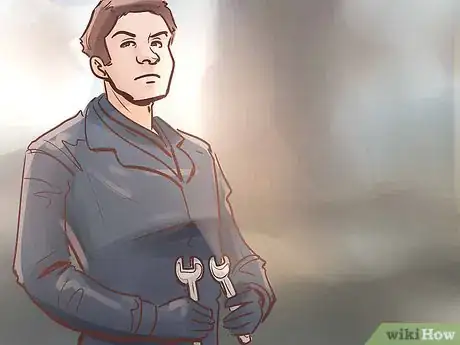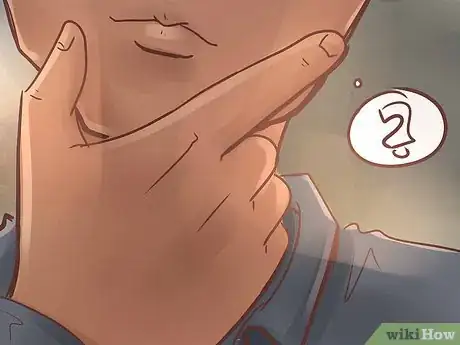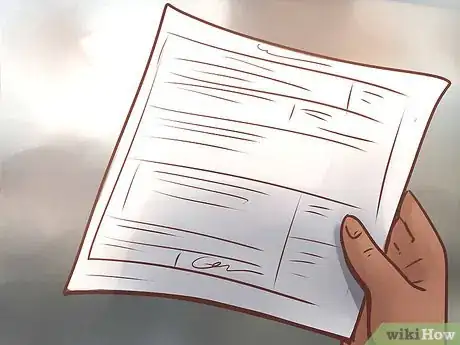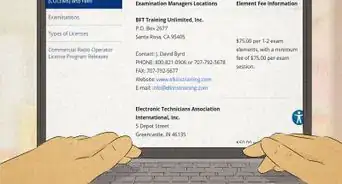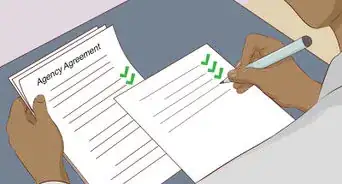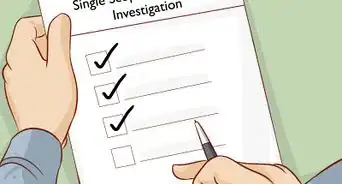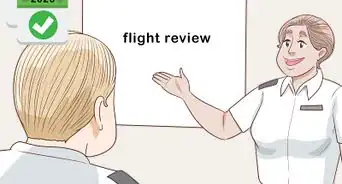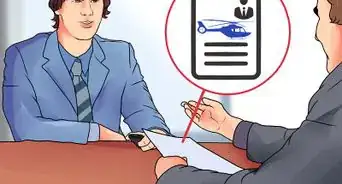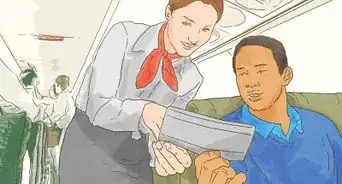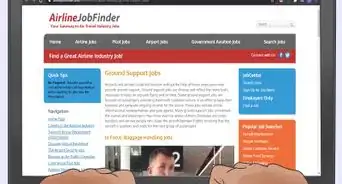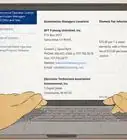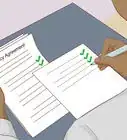This article was co-authored by wikiHow Staff. Our trained team of editors and researchers validate articles for accuracy and comprehensiveness. wikiHow's Content Management Team carefully monitors the work from our editorial staff to ensure that each article is backed by trusted research and meets our high quality standards.
This article has been viewed 77,228 times.
Learn more...
To start a career as an Aviation Maintenance technician (AMT), you'll need specialized training, and you'll need to be certified by the Federal Aviation Administration (FAA). To become certified, you'll need 18 to 30 months of practical work experience at an FAA-approved facility, and you'll have to pass practical and written exams. You can work in the armed forces as an aircraft mechanic without a license, but once you leave the service you'll need to obtain FAA certification unless you plan to work under direct supervision of a licensed aircraft mechanic.
Steps
Acquiring Work Experience as a Civilian
-
1Go to school. There are 170 Aviation Maintenance Technician schools in the US, that are approved by the Federal Aviation Administration (FAA). Programs usually last 12 to 24 months, and most require a high school degree or a GED.[1]
- Graduation qualifies you to sit for the FAA exams required for certification.
- Graduates often earn higher salaries than mechanics who get their experience through apprenticeship or the military.
-
2Work as an apprentice. If you do not have a mechanic's license from the Federal Aviation Administration (FAA), you can still work on avionics equipment in a limited capacity. You'll need 18 months of practical, on-the-job experience for each type of certificate (power plant or airframes), or 30 months total to get both certificates.
- You will be allowed to work only under direct supervision of someone who has an FAA mechanic's license.
- You'll be required to produce proof of the work you did – pay stubs, and a letter from your employer – before you can take the FAA tests.
- You will not be authorized to approve planes, engines, appliances, or parts to be returned to service. Someone with a license will need to sign off on that.
- Without a license, you will be restricted to basic mechanical work, and will not advance to higher levels in the business.
Advertisement -
3Prepare yourself for a challenging work environment. Avionics mechanics can earn very good salaries, and the work tends to be interesting and varied. However, there are pros and cons that you should be aware of if you are considering this career path.[2]
- You'll be using sophisticated equipment and potentially dangerous power tools.
- New mechanics are usually expected to work weekends and nights, because work is needed 24 hours a day, 7 days a week. The better shifts go to mechanics with seniority.
- You'll be working in environments where the noise levels are extremely high.
- The work is very physical and involves climbing, crawling, and carrying heavy parts.
- You will work against tight deadlines – the planes need to be ready on time, every time. This can be very stressful for some people.
Acquiring Work Experience through the Armed Forces
-
1Choose an approved job speciality. Your practical experience in the military is only applicable to certification if it's one of the specific jobs that has been approved by the Federal Aviation Administration (FAA). You'll need to contact your local FAA Flight Standards District Office (FSDO) for a list of these jobs, because the list changes without notice. Your military recruiter should also be familiar with specific job listings for FAA certification requirements.[3]
- Each branch of the military has its own job codes. There are more than 50 MOS codes for the Air Force that describe jobs that are reported as being FAA-approved work experience.
- The US Army has around 20 specific MOS job codes that qualify, including: 15N10/30 (Avionics Mechanic, Airframe experience), 15M10/30 (UH-1 Helicopter Repairer, Airframe and Powerplant experience), and 15B10/30 (Aircraft Powerplant Repairer, Powerplant experience).
-
2Contact a military recruiter. If you believe you meet the basic requirements for US military eligibility, you can get in touch with your local recruitment office at military.com. Basic military requirements are:[4]
- Be a US citizen or resident alien.
- You'll need to be at least 18, or 17 with permission from your legal guardian.
- Most jobs require a high school diploma (there are a few that will allow a GED, but not many.)
- You'll need to be in good physical and mental condition, and pass medical examinations.
- You will need to pass two separate drug tests.
- For the Air Force, you must also have an AFQT score of at least 50, be between 17 and 27 years old, and have no more than two dependents.
- For the Army, you must be between 17 and 34, have no more than two dependents, and have a minimum AFQT score of 31.
- For the Marines, you must be between the ages of 17 and 29, and have a minimum score of 32 on the AFQT. Women are allowed to serve in all jobs except combat positions.
- For the Navy, you must be between 17 an 34, and have a minimum AFQT score of 50. Women are allowed to sign up for any job except the Navy Seals and positions on submarines.
-
3Work as an aircraft mechanic in the military. Jobs vary in each branch of the US military, so you will need to speak to a recruiter to get specific details about aircraft mechanic positions. Each branch of the military has its own basic requirements for enlisting.[5]
- Certain occupations have additional requirements beyond the basics, such as a certain score on the Armed Services Vocational Aptitude Battery (ASVAB) test.
- You may need to demonstrate aptitude in math, science, and technology to convince a recruiter you'd do well as an avionics mechanic (through test scores or your school transcript).
-
4Get an official letter from your superior. When you leave the service, you'll need to get a letter from your boss listing the types of aircraft and engines you worked on, and how many hours of practical experience you received. Training time does not count toward practical experience hours, only actual hours worked.[6]
Obtaining Aircraft Mechanic Certification
-
1Pass the oral and practical examinations. Once you have obtained the required amount of practical training, you will need to pass three tests administered by the Federal Aviation Administration (FAA).[7]
- A Designated Mechanic Examiner will test your practical skills.
- The Examiner will also administer an oral exam – you'll answer his questions in person, while he takes notes.
- There are 43 different technical topics that you'll need to be familiar with in order to pass these tests.
- For a single certificate exam (airframe or power plant), expect the test to last about 8 hours.
-
2Pass the written exam. You will need to go to your local Federal Aviation Administration (FAA) office and submit proof that you have all the required experience for certification. If the FAA inspector determines that you are eligible to take the written exam, you can schedule your exam at one of the approved computer testing centers. There are testing centers in most large towns and cities in the US.
- Study very carefully for your written exam. If you fail any part of the test, you'll need to wait at least 30 days before taking it again.
- The 30-day wait requirement may be waived if you can show proof that you've gotten additional training in the area you failed.
- Every section of the written exam must be passed within 24 months of your first attempt.
-
3Get a mechanic's license from the Federal Aviation Administration (FAA). You can get a license in a power plant rating, an airframe rating, or both. you are a US citizen and want to work as an aircraft mechanic in the United States, you must meet certain basic standards. You will need a mechanic's certificate to work as an aircraft mechanic.
- You must be 18 years of age, or older.
- You must be able to speak, write, read, and comprehend English.
- You must have 18 months of practical experience with airframes or power plants, or 30 months of practical experience working on both power plants and airframes at the same time.
- You must pass the required practical, oral, and written exams.
-
4Get a mechanic's license from the Federal Aviation Administration (FAA) requirement if you are not a US citizen. If you aren't a US citizen, you can still qualify for a mechanic's certificate if you meet all of the US citizen standards, along with some additional requirements.
- You'll need to prove that you need a mechanic's certificate to work on US-registered civil aircraft.
- You will need to show your non-US passport to the examiner.
- Your employer will need to write a letter explaining exactly what aircraft mechanical work you performed for him, and for how long.
- You will need a letter from the foreign equivalent of the FAA listing your qualifying work experience, or a letter to this effect from the International Civil Aviation Organization (ICAO).
- All papers must be dated and signed, and must be the original document – no copies are allowed.
- You'll need to pay a fee to have your documents reviewed by FAA officials.
- English-language requirements are occasionally waived if you will not be working within the US. In this situation, your license would limit you to work outside the US.
-
5Get a repairman certificate, if you are already on the job. The Federal Aviation Administration (FAA) also issues repairman certificates, which restrict the bearer to specific tasks (such as repairing a specific type of engine or engine component, for a specific type of aircraft). The work is performed for commercial operators, FAA-approved repair stations, or air carriers that have been approved to do this kind of work. The requirements for a repairman certificate are:
- Your employer will need to recommend you for a repairman certificate before you can apply.
- You'll need to be 18 or older.
- You must be able to write, read, understand, and speak the English language.
- You will need work experience that qualifies you to perform maintenance on aircraft or parts.
- You must already be employed on a specific job that requires qualifications by an FAA-certified Repair Station, air carrier, or commercial operator.
- You will need 18 months of on-the-job experience in the specific job that you will be doing with your repairman certificate, or you will need to complete a school training course at an FAA-approved facility.
Community Q&A
-
QuestionHow much should I expect to spend on aircraft mechanic school?
 Community AnswerThe amount of money you spend on your training depends entirely on the school you choose to attend. If you choose to join the military to get your experience, you can avoid this expense.
Community AnswerThe amount of money you spend on your training depends entirely on the school you choose to attend. If you choose to join the military to get your experience, you can avoid this expense. -
Questiondo you need a'level to study aircraft mechanics
 Community AnswerThe requirements are different in the UK, but it appears that most universities do require A levels for this type of program.
Community AnswerThe requirements are different in the UK, but it appears that most universities do require A levels for this type of program. -
Questionwhere can I find the "best" air craft mechanic school in phoenix, arizona? thanks.
 Community AnswerThe FAA maintains a list of approved schools, broken down by state. You can find the list on their website.
Community AnswerThe FAA maintains a list of approved schools, broken down by state. You can find the list on their website.
References
- ↑ https://www.faa.gov/mechanics/become/experience/
- ↑ https://www.faa.gov/mechanics/become/faq/
- ↑ http://www.airframeandpowerplant.com/Army.htm
- ↑ http://www.military.com/join-armed-forces/join-the-military-basic-eligibility.html
- ↑ http://todaysmilitary.com/faq
- ↑ https://www.faa.gov/mechanics/become/experience/
- ↑ https://www.faa.gov/mechanics/become/test_requirements/
About This Article
If you’d like to become an aircraft mechanic, start by making sure you’re ready to work long hours in noisy, high-pressure environments with tight deadlines. If you feel this is the right career for you, you’ll need to graduate from an Aviation Maintenance Technical School and work as an apprentice for 18 months to earn your power plant or airframes certification. Then, you can apply for an aircraft mechanic license and repairman certification, which will allow you to work on aircrafts and aircraft components. For more advice, including how to find work as an aircraft mechanic in the military, keep reading!


